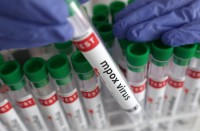WASHINGTON
(Reuters) – Researchers have succeeded in turning ordinary cardiac muscle cells into specialized ones that deliver a steady heartbeat using a gene therapy procedure they predict could become an alternative to implanted electronic pacemakers.
A study published on Wednesday involved pigs with a condition called heart block that makes their hearts beat too slowly. By injecting a human gene into a tiny region of the heart’s pumping chambers roughly the size of a peppercorn, the researchers reprogrammed heart muscle cells into a type of cell that emits electrical impulses to drive the beating heart.
In doing so, cardiologists at Cedars-Sinai Heart Institute in Los Angeles created “biological pacemaker” cells that restored a normal heart rate in the pigs. The procedure achieved the same result as implanting an electronic pacemaker that sends electrical pulses to the heart if it beats too slowly or skips a beat.
“This development heralds a new era of gene therapy where genes are used not only to correct a deficiency disorder but actually to convert one type of cell into another to treat disease,” Dr. Eduardo Marbán, director of the Cedars-Sinai Heart Institute and leader of the research team, told reporters.
The researchers noted that pig hearts are very similar to human hearts. Dr. Eugenio Cingolani, director of the institute’s Cardiogenetics-Familial Arrhythmia Clinic, said “if all goes well” in further animal studies examining the procedure’s long-term effectiveness and safety, “we hope to be able to begin trials in humans within three years.”
The researchers envision using the procedure initially to help people with heart rhythm disorders who cannot use a pacemaker because of device-related complications like an infection or in fetuses in the womb with congenital heart block.
Such fetuses cannot have a pacemaker implanted and risk severe heart failure often resulting in stillbirth. The researchers hope to develop an injection-based treatment to deliver the gene therapy to these developing babies.
They said down the road the procedure might be used in a broader patient population as a realistic alternative to the pacemaker. Marbán said about 2 percent of pacemakers lead to an infection requiring treatment. In the United States alone, about 300,000 people get pacemakers annually.
“Rather than having to undergo implantation with a metallic device that needs to be replaced regularly and can fail or become infected, patients may someday be able to undergo a single gene injection and be cured of the slow heart rhythm forever,” Cingolani said.
Using a minimally invasive catheter procedure, the researchers injected pigs that had complete heart block with a gene called TBX18 that is responsible for a protein that makes the heart keep the right rhythm. On the second day after the gene was injected, the pigs developed a faster, more normal heartbeat that lasted for the rest of the 14-day experiment.
The researchers used a common type of virus called an adenovirus to introduce the gene into the pigs but expressed confidence the virus poses minimal risk.
The research appears in the journal Science Translational Medicine.
(Reporting by Will Dunham; Editing by Tom Brown)







